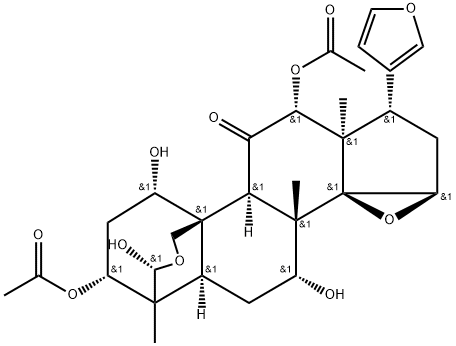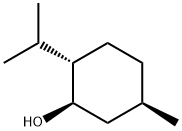Santonin , >98.0%(HPLC) , 481-06-1
Synonym(s):
(−)-α-Santonin;(3S,5aS,9bS)-3a,5,5a,9b-Tetrahydro-3,5a,9-trimethylnaphtho[1,2-b]furan-2,8(3H,4H)dione;Semenen
CAS NO.:481-06-1
Empirical Formula: C15H18O3
Molecular Weight: 246.3
MDL number: MFCD00135865
EINECS: 207-560-7
| Pack Size | Price | Stock | Quantity |
| 1G | RMB111.20 | In Stock |
|
| 5G | RMB383.20 | In Stock |
|
| 25G | RMB1056.00 | In Stock |
|
| others | Enquire |
PRODUCT Properties
| Melting point: | 172-173 °C(lit.) |
| Boiling point: | 329.3°C (rough estimate) |
| Density | 1.5900 |
| refractive index | -172.5 ° (C=2, CHCl3) |
| storage temp. | 2-8°C |
| solubility | Chloroform (Slightly) |
| form | Solid |
| color | White to Off-White |
| Water Solubility | 0.2g/L(17.5 ºC) |
| Merck | 14,8361 |
| BRN | 89489 |
| Stability: | Hygroscopic |
| LogP | 1.600 (est) |
| CAS DataBase Reference | 481-06-1(CAS DataBase Reference) |
| EPA Substance Registry System | Santonin (481-06-1) |
Description and Uses
Santonin is a lactone compound extracted from the flower bud of Artemisia cina
Berg in Compositae, crown daisy chrysanthemum or other plants in Artemisia. It
has been recorded in ancient China . Its English name is santonica wormseed,
Chinese alias is ‘quhaosu’ and Latin name is Seriphidium cinum (Berg ex Poljak.)
Pol-jak. . Santonica wormseed, a variant name for Artemisia
cina Berg, is the leaf and anthotaxy of Artemisia cina Berg in sagebrush plants in
Compositae. There are more than 100 plus in sagebrush, in which about 30 plus live
in China, and parts of them can be used medicinally.
Santonica wormseed, used as raw material to extract and manufacture santonin,
lives in cold, dry sandy loam. The place of origin is the Southern Central Asia in
the former Soviet Union. China introduced the earliest cultivation in Xinjiang, and
now it is introduced and cultivated in the North, Northeast and Northwest China.
Santonica wormseed mainly contains hispidulin, quercetin and caffeic acid, and its flower contains 1–3.5% α-santonin, 1–3% artemisinin and volatile oil (mainly
is 1, 8-cineole) and so on. Leaf also contains a small amount of α-santonin. In
addition, it also contains β-cintonin, 3,4,5,7-tetrahydroxy-3-methoxyflavone7-
glucoside and aglucone.
(?)-α-Santonin has been used as a eudesmane-type sesquiterpene to study its effects on impairment of 231MFP breast cancer cell survival.
Safety
| Symbol(GHS) |  GHS06 |
| Signal word | Danger |
| Hazard statements | H301+H311+H331 |
| Precautionary statements | P280-P301+P310+P330-P302+P352+P312-P304+P340+P311 |
| Hazard Codes | Xn,Xi,T+ |
| Risk Statements | 22-36/37/38-26/27/28 |
| Safety Statements | 22-24/25-45-37-36-28-26 |
| RIDADR | 2811 |
| WGK Germany | 3 |
| RTECS | LE3150000 |
| HS Code | 2932.99.7000 |
| HazardClass | 6.1(a) |
| PackingGroup | II |




